How to feast like a local on a foodie tour through Cambodia
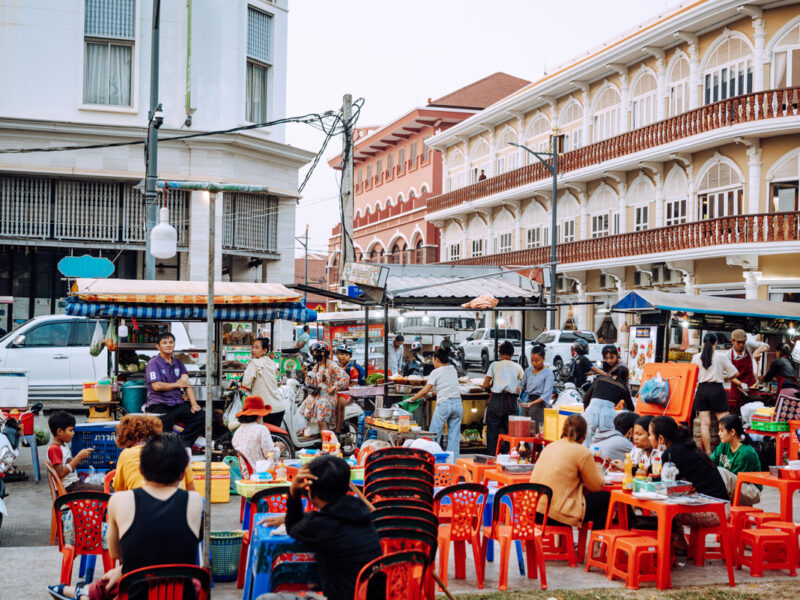
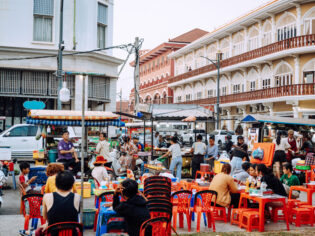
An unflinchingly authentic food tour around Cambodia serves up a slice of real life and culture.
There’s no mistaking what I’m about to eat. The rodent is splayed and prone on a roadside grill with its tail dangling over the edge, teeth bared and dauntingly intact. My brain struggles with the notion that this is a good idea. I watch with mild unease as the best rat is selected and hoisted up by its charred tail for all to appreciate. It lands with a thwack on the chopping block, where it’s swiftly jointed and served in situ with a dipping sauce.
Facing culinary fears: from rat to rotisserie pork
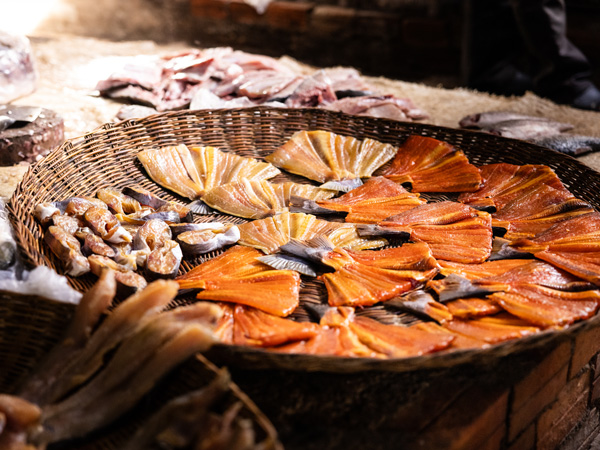
The food markets of Siem Reap are brimming with local cuisine.
Standing in the dust under a tattered tarpaulin en route to Battambang from Siem Reap, I hesitate, briefly, at the prospect of partaking in this snack. Some self-talk is required to proceed. This is what I’m here for. I’ve joined a seven-day Intrepid Travel adventure, one of Southeast Asia’s most memorable journeys. The goal? To discover the culinary traditions of this beautiful country, and so if rat is on the menu, rat is what I shall eat.
And I do. And of course it tastes like chicken. But this is no filthy urban scavenger; it’s a rural, clean-living rice paddy rat, which enjoys a diet of the ubiquitous grain. Let’s be honest, a serving of rodent marinated in pepper, garlic, palm sugar and salt is going to be far better for you than the cheeseburger you’d usually devour on a road trip. Although relief ensues when we’re herded back onto the bus before the opportunity to sample the coiled snakes and spread-eagled frogs presents itself.
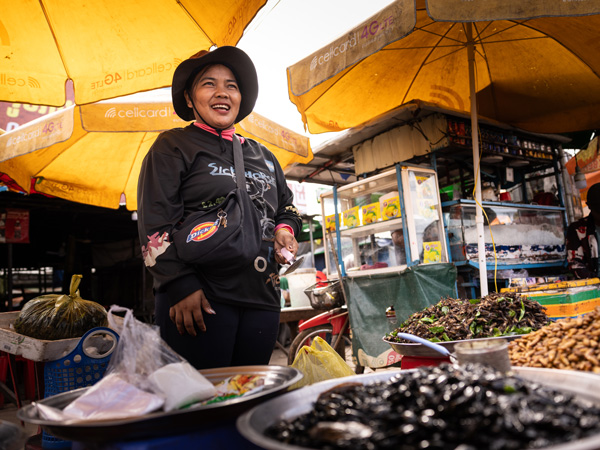
Meet locals as they serve up their favourite authentic snacks.
Our guide, the liberally smiling Fila Heng, is giddy with delight that his Western charges have sampled a delicacy of his beloved Cambodia and rather enjoyed it. Throughout the trip, Fila is frequently given to directing our driver to pull over so he can bound off to purchase this or that for us to try, from bags of sugary, fried biscuits to rustic rotisserie pork.
With each snack is a story, a recounting of history – national or personal – and a ceaseless spring of exuberance. I’ve been on Intrepid Travel tours before, and the common thread is that its tour leaders are genuine rock stars with an authentic zeal for their country.
The curiosities and delights of Puok Market
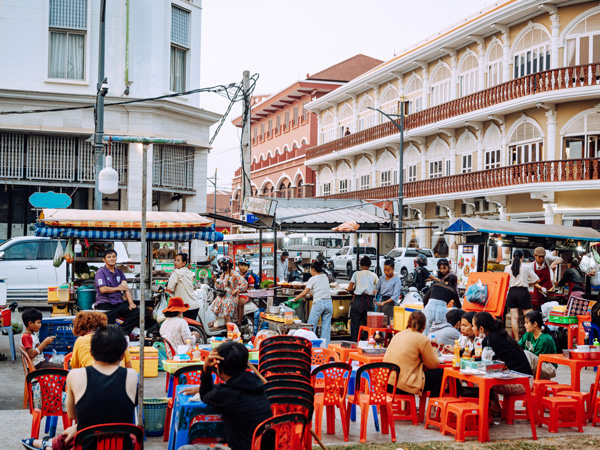
The best way to tackle markets is with a local guide. (Image: Getty Images/Nikada)
This couldn’t be more evident than when Fila leads us through Puok Market after another swift swerve off-road, just 20 minutes from Siem Reap, considered one of the world’s most incredible cities. Filo is hailed by the sellers with jovial quips as we weave through the tightly packed snarl of stalls. Despite translations being necessary, the entire group falls into a laughter-filled exchange with the ladies of the market. Noting our snapping cameras, they joke that their faces might soon end up on soy sauce bottles back in Australia.
Fila winds us through stalls piled high with rambutans, mangosteens, longans, snake and dragon fruits, and past baskets fanned with smoked fish, bright-red sausages, netted tubs of thrashing catfish and pigs’ heads gazing skywards. But it’s the enormous trays of insects that Fila has in mind.
He selects a large, shiny-black water beetle, casually pops off its head and crunches down with considerable gusto. It’s reminiscent of a scene from Indiana Jones and the Temple of Doom and a little meatier than I like my insects. But the crickets stir-fried with pork fat, lemongrass, makrut lime leaves and chilli are deliciously snackable.
Why food culture in Cambodia is more than just flavours
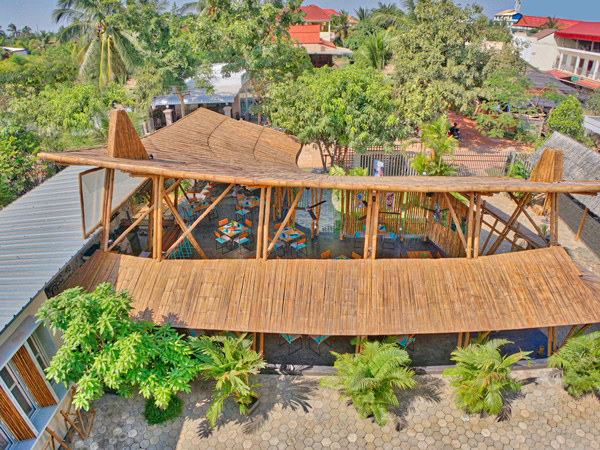
Spoons Cambodia is a good restaurant with a great cause.
It’s not all insects and rodents, though. The food culture in Cambodia is highly approachable, steeped in tradition and redolent of the region’s ingredients, such as the prized Kampot pepper. We spend an evening wandering by the riverside and snacking on classic Khmer street food in Siem Reap. Guided by Fila, we tuck into smoky-sweet beef skewers hot off the grill and pork rolls that are similar to a bánh mì, but dialled up with tangy green mango and alabaster lard.
We also sip on cocktails made with local rice wine. And dine on nime chow (Cambodian spring rolls) at Spoons Cambodia, a social enterprise that trains students out of poverty through hospitality skills. We also enjoy the King’s go-to dish, fish amok, a mousse-like leaf-wrapped curried fish at the refined Malis. And sample Fila’s favourite soup filled with delicate bamboo shoots and pungent smoked river fish.
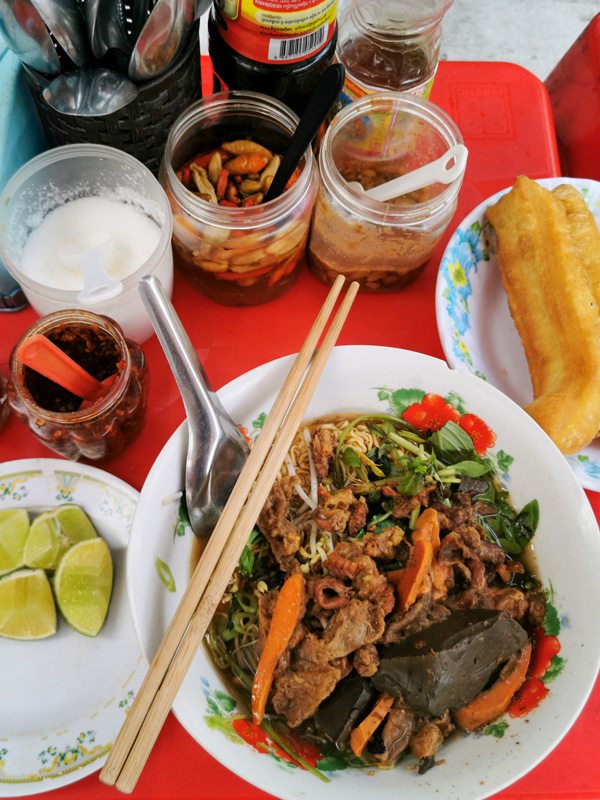
Nam banh chok is a traditional Khmer breakfast dish. (Image: Getty Images/Nalidsa Sukprasert)
It’s the humble Khmer breakfast dish called nam banh chok, though, that I continue to crave. Venturing to the noodle-famous village of Preah Dak, we relish bowlfuls of handmade yellow rice noodles submerged in a coconut- and fish-based sauce. The dish embodies that holy trinity of sweet, sour and savoury, which the Southeast Asian culinary canon masters so well.
Without being privy to the work that goes into making these slippery strands, you might think this was a simple dish. Before we sit down to slurp, we watch everyone in the family, from grandma to grandson-in-law, partake in the production process. A lot of work is involved to soak, grind, steam, pound, knead and extrude the rice into noodle nests by hand using an impressive stone mill. There is a joyful purpose and evident pride in the result.
How families are upholding tradition in the face of change
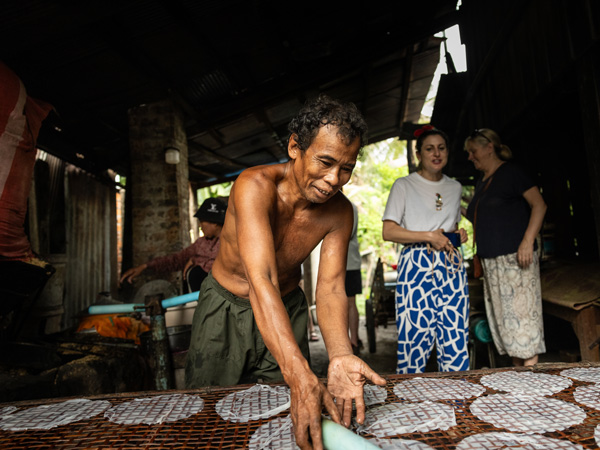
Visit families still making rice paper in Battambang on a Soksabike tour.
While industrialisation has alleviated much of the labour that goes into producing traditional foods in Cambodia, there remains a dwindling number of families that continue to specialise in these crafts. In Battambang, we pedalled the back roads with social enterprise company Soksabike to drop in on families still making rice paper, dried banana and bamboo sticky rice the old-fashioned way.
The recurring theme was a perseverance to preserve this important part of Khmer culture, despite the younger generation opting for office jobs over days spent crouching by cauldrons of steaming rice. It’s both understandable and somewhat devastating.

Don’t miss the UNESCO World Heritage Temples of Angkor Wat. (Image: Getty Images/Hippo Studio)
It’s been a slow crawl back from the decimation wrought by the Khmer Rouge in the 1970s. But there’s a definite sense that no one wants to give the tragedy airtime. They’d rather focus on the tenacity and achievements of the Khmer people. After all, the Khmer Empire, which flourished between the 9th to 13th centuries, was one of the most powerful in the world, building incredibly intricate temples, such as the sprawling UNESCO World Heritage Temples of Angkor.
Beyond your taste buds: experience the real Cambodia
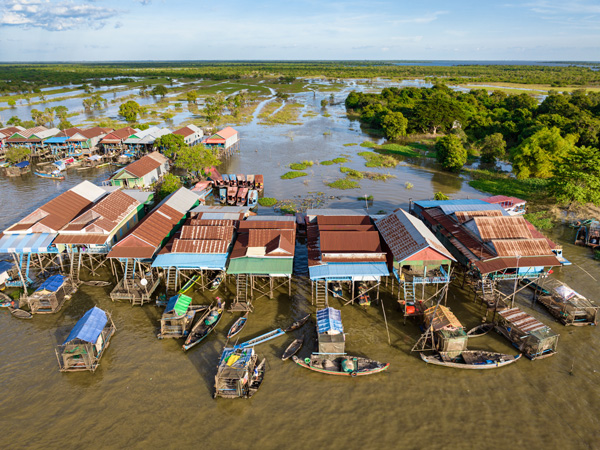
Tonlé Sap is an inland lake with floating villages. (Image: Getty Images/M Lenny)
The soothingly symmetrical Angkor Wat is an ethereal sight at sunrise as soft, lilac hues slowly coax the towers out from the darkness. Ta Prohm, or Jungle Temple, which you may remember from the Jolie-era Lara Croft: Tomb Raider movie, exists here in an enigmatic clutch of tree roots as the encroaching jungle indolently ingests the stone monument.
Other examples of mystifying innovation and beauty in Cambodia include myriad temples that tippy-toe on mountaintops and the floating villages of inland lake Tonlé Sap – haphazard watery outposts that appear as if conjured by some mysterious deity.
There is a palpable arc of history, some of it uplifting, some heartbreaking, that canopies Cambodia. But the essence of warmth and light that lives in the Khmer people is rich and tantalising and finds its way into the incredible food of this country. It’s a pink plastic tub of blue crabs bobbing with iridescent green and red chillies. It’s the quick-smiling locals serving scoops of golden silk cocoons. And it’s the heady scent of the rice flower in bloom.
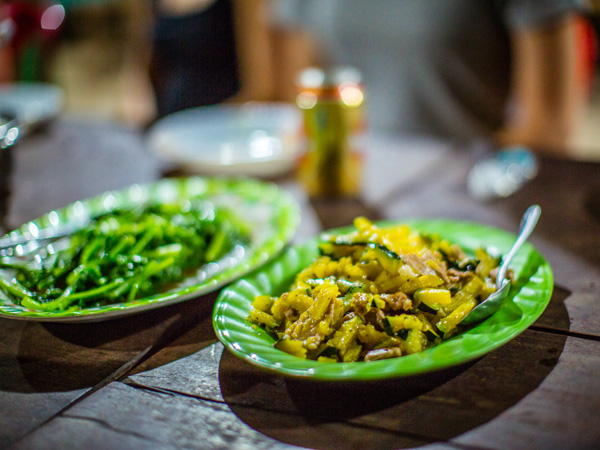
Vegetables are a staple of Cambodian cuisine. (Image: Ryan Bolton)
I consider all this as I wait for a bat colony to make its nightly exit from the innards of an ominous-looking cave at Phnom Sampov. The bats are running late, so I see what Fila’s up to at a nearby table. He’s helping himself to a willing stranger’s plate of balut.
He offers me a taste while demonstrating how to eat the developed egg embryo. I spy the immature beak and feathers of the never-to-hatch chicken and politely decline. No amount of self-talk can reprogram my Aussie sensibilities to find an entombed embryo appealing. I’ll have another serve of rat, though.
Intrepid Travel’s eight-day Cambodia Real Food Adventure winds from Phnom Penh to Siem Reap, sampling Khmer flavours, culture and history. Prices from $1880; single supplement from $270.
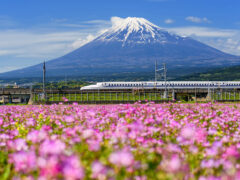
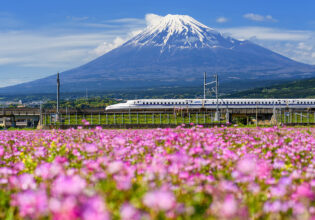
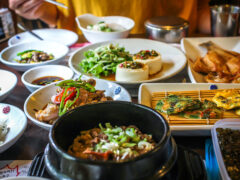
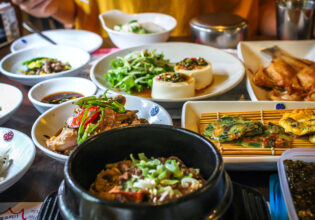
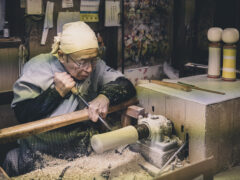
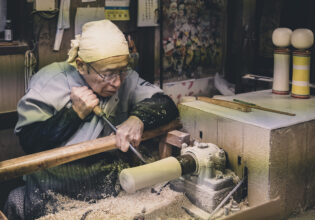

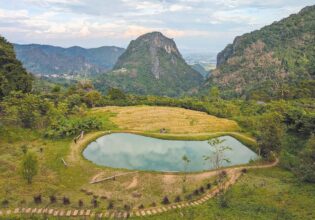


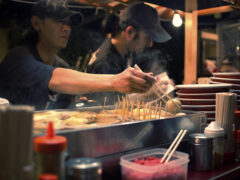
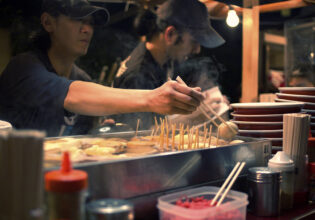


LEAVE YOUR COMMENT